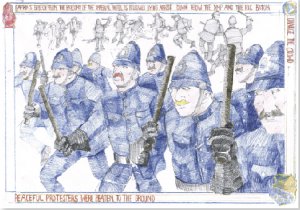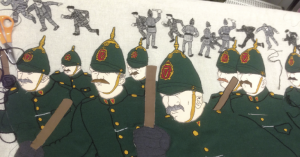The Lockout Tapestry —a stitch in time
Published in 1913, 20th Century Social Perspectives, 20th-century / Contemporary History, Issue 4 (July-August 2013), News, Volume 21 The 1913 Lockout Tapestry is an ambitious, large-scale, collaborative visual arts project to commemorate the Dublin Lockout. During this epic struggle an estimated 100,000 people, one third of the capital’s inhabitants, faced starvation for five months in a battle for workers’ rights. The Lockout of 1913 is unique in the ‘decade of centenaries’ that we are now entering (1912–23) in that it was a conflict between capital and labour rather than along the traditional dividing lines of religion and nationality. It was also the first major conflict in Irish history that was urban-centred.
The 1913 Lockout Tapestry is an ambitious, large-scale, collaborative visual arts project to commemorate the Dublin Lockout. During this epic struggle an estimated 100,000 people, one third of the capital’s inhabitants, faced starvation for five months in a battle for workers’ rights. The Lockout of 1913 is unique in the ‘decade of centenaries’ that we are now entering (1912–23) in that it was a conflict between capital and labour rather than along the traditional dividing lines of religion and nationality. It was also the first major conflict in Irish history that was urban-centred.
The issues remain current—and unresolved—today. They revolve around the basic rights to collective bargaining, workplace representation, free speech and freedom of assembly.
The Tapestry consists of 32 panels laid out in a ‘comic book’ style. It is a ‘multimedia textile piece’ made up of 60cm x 76cm (2ft x 2.5ft) embroidered cloth panels. These will be completed by August 2013 to coincide with the centenary of the Lockout. The approach adopted is a participative one that involves people in reclaiming and understanding their own past rather than passively accepting the authorised version handed down by academics, politicians, the commercial media and powerful established interests. Painters Cathy Henderson and Robert Ballagh were commissioned by SIPTU and the NCAD (National College of Art and Design) to design this ‘visual narrative’. The only condition is that nothing should appear in the Tapestry that is not historically verifiable. They were provided with a narrative timeline and have been free to interpret it as they see fit.
Work began on the Tapestry last year and the pace has become increasingly hectic as deadlines approach. There are currently almost 100 volunteers working on panels, as well as school students and prisoners in Limerick and Mountjoy.

An early sketch of the ‘Bloody Sunday’ panel by Cathy Henderson and (left) the finished embroidered panel by women from the Patchwork Society. (SIPTU/NCAD)
Opening hours at the Tara House production centre on Tara Street, Dublin, were extended to ensure that the end of June deadline was met. Volunteers work in a spare office space provided by CIE. Without this assistance it is unlikely that the Tapestry could have been completed. There is a certain historic irony in having CIE as the landlord, because the company can trace its origins to the Dublin United Tramway Company, on whose trams the Lockout began.
When the Tapestry is completed it will be unveiled by President Michael D. Higgins at Liberty Hall, where it was formally launched on 6 November 2012. It will then be available to go on tour, as the aim is to have it on display as much as possible. It is part of the centenary programme organised by the Irish Congress of Trade Unions. HI
Read More : Groups Participating
















